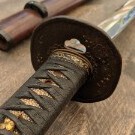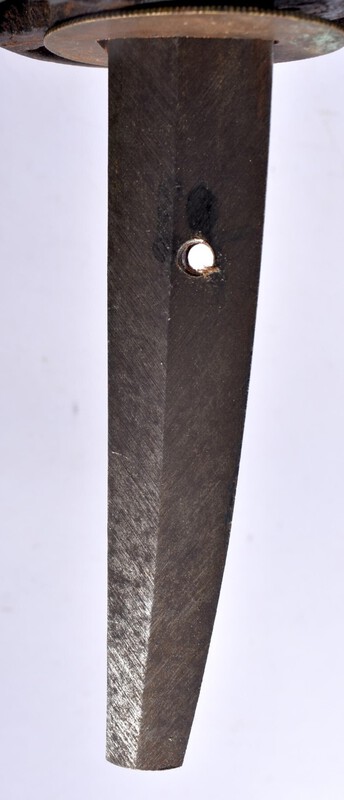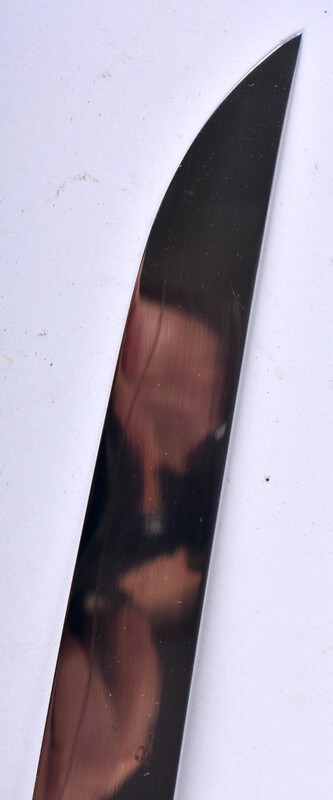-
Posts
228 -
Joined
-
Last visited
Everything posted by George KN
-
My humble opinion as a novice collector is that so long as no harm is being done to the blade, then what fittings you want to use is a matter purely of personal taste. As I understand, people have often changed the koshirae to fit the times and their own desires, and as caretakers of these historic objects, we can also be part of that tradition (and maybe in a few hundred years time someone will be having a very similar debate over whether they should be removing a 21st century tsuba from an 18th century sword ) This thread does raise an interesting and related question I've had since I've been collecting though - is it ever acceptable to have new holes made in an antique katana to fit a particular antique tsuka? And if not (and I understand this would heavily devalue an ubu sword), doesn't that make finding antique koshirae that fits a particular sword almost a game of chance? (especially when buying online).
-
Thank you for the tips, I very much look forward to giving it that final clean! (I will also get some better photos later) And thanks Dale, another Pea tsuba! There must be a *lot* of them floating around... It is interesting that one looks like it has been mounted though. I very much hope you are right about the Shakudo
-
Thanks Grev, I thought about not sharing my findings since it's embarrassing admitting to such mistakes, but I hope it helps prevent someone else from making them. As to the mei, it is very faint even in person - I can only really distinguish two horizontal lines with *something* between them. I hope further cleaning over time will help reveal more, in which case I'll happily share, as I would very much like to know as much as possible about this tsuba after spending so long working on it.
-
I have been working on the tsuba now for many weeks on and off, and I have to say the upgrade from wooden toothpick to bone has made a massive difference! The bone easily scratches off rust, leaving the patina for the most part unharmed. However, a few costly lessons have been learned so far - and I'm putting them here in case others try this. 1. Bone can scratch Shakudo 2. Bone will eventually scratch/wear through patina 3. Cleaning will reveal existing damage or flaws However, my most painful lesson: 4. Flaked rust or metal from the cleaning can get under the tsuba if you are cleaning on a table/hard surface, and as you continue to clean and apply pressure to the tsuba, scratch the Shakudo without you noticing That last one really hurt when I flipped over the tsuba to find the new marks - and I'm angry at myself for not thinking about it beforehand Now I do the cleaning on a pad of white paper, which is nice and soft and also makes it easy to notice and clean the dust/flakes. On the bright side, the tsuba's iron has continued to look better and better - and I think perhaps slowly giving up some secrets... Does this look like a signature to anyone else on the left of the ana?
-
Super useful tips on this thread! Apart from making/adapting my own, is there a recognized best place to buy boxes? (At the moment I could do with only two good ones, but I have a few extra rougher tsuba that at least deserve *something* to be stored in properly - oh, and I'm UK based if that's relevant)
-
It is a complete minefield out there, I agree! And the prices you've both quoted are right, especially for buying from dealers or other collectors. But I will raise you this - my first two swords I bought at auction for £1674.40 (plus ~£100 shipping), unpapered, mumei, and damaged saya sure, but there is hope for finding some half decent swords in my price range... It's just a very risky business, that takes a lot of sifting, occasionally a bit of pestering on the forums, and a lot of patience. I also can't help but think that when I do buy from auction I might also be saving a sword or tsuba from a horrendous fate - as although I'm sure I make mistakes from time to time, I'm at least not going to begin trying to use acid on them or chop things up for fun, and instead keep them on display and in good condition. So there's that side of the bargain hunting I definitely enjoy too. One day I will save up enough to buy a papered blade, or hopefully, at least get these two properly polished and sent of for their own papers, that would be really cool! I'm just not there yet (really should be buying a car instead of more blades, but I know which one I'd rather have )
-
Thanks guys, I have now mentally written off all these blades as essentially valueless - that last one was the only one I had a doubt on. With regards to the best way to go about collecting, I do appreciate the sentiment that buying things at auction is incredibly risky, especially when relatively new to the subject. However, with regards to purchasing papered blades, I'm simply not able to afford them... And importing into the UK isn't great either, so I am somewhat stuck trawling the auctions looking for opportunities under the <£1k mark.
-
Since this thread exists, and now needs a purpose beyond the other thread discussing the obscenity of the auction as a whole - there is one sword in particular I think might be real... It hasn't got any of that fake rust, and hasn't been completely polished to oblivion - do you think it would be worth a punt? I can't imagine it is too old judging from the patina alone, but I assume it is an antique? Also worth mentioning the tsuba has a crack in it...
-
So I'm still on the hunt for my third sword, and there is an auction coming up I'm interested in. There are nearly 50 lots in this one auction, and some of the Katana, Wakizashi, and Tanto look interesting, and the koshirae on many of them is actually pretty decent. However, almost all of them have exactly the same mirror finish on the blades, as well as strangely rusted nakago. What's concerning me about the rust is it looks very fresh, almost like water damage - and what signatures there are seem clumsy to me. The mirror finish on the blades also seems to rob any real view of their quality, and they all seem to be missing their yokote too. Some of them have rusted in a way that makes me think acid has been used at some stage too. I'll attach a few images below - each nakago will be from a separate blade, and I'd love to hear what you think whether they are real? Thanks, George Edit: I had not realised this had been raised in a different thread - I have changed my question below
-
Thanks @kissakai, and funnily enough I am already planning to make some bone picks/awls, to see if they are able to remove some of the more stubborn rust in the more awkward spots. I've actually got the beef bone from the butcher sitting in my fridge already, so I'll let you know how it goes once I make them 🙂
-
In terms of others damaging their tsuba (or even myself if this eventually turns out badly), I would like to clarify I wouldn't use water displacer if it wasn't that these tsuba were so heavily rusted, because I do definitely recognise the inherent risk with any sort of restoration/maintenance, and people should never attempt such things without admitting they may destroy the beautiful pieces of history they are trying to protect. I wouldn't ever go anywhere near them with anything harder than bone, and even then I suspect you could scratch the Shakudo (wood doesn't seem to be able too, which is why I continued with it, even thought it is very slow going). It really is a risk vs reward situation - I knew the rust was so bad it was actively destroying them and needed stopping. I just couldn't in good conscience leave them like that.
-
Hi @ROKUJURO, As mentioned before, I have used WD40 on other antiques before (such as a rusty bayonet), with decent results. I understand it is controversial because it is a modern chemical compound, but it genuinely seems to have very little negative effect on old patina and old iron from my observations, as you said it mostly evaporates away, and I believe it is a type of oil anyhow (it's certainly how it acts on metal). After all, they *needed* treatment against the rust. An other alternative I had heard about and considered was boiling them in water (which I believe is a type of bluing like on a firearm), but I didn't want to risk that in case it simply converted the red rust to black rather than just removing it like the water displacer/cocktail sticks does... Edit: I should add I'm very much open to knowing if there are negative affects to WD40, or better alternatives, I just aren't aware of them?
-
I may get crucified by some of you for my methods, but over the past week or so I have been gently treating the rust on all four tsuba using WD40 and wooden cocktail sticks. I did do research before trying this, and there seems to be as many different cleaning methods as there are members on this forum... But I've used WD40 on other rusty antiques before, and knew it wouldn't touch the patina. It just slowly dries out the rust, allowing it to be dislodged, and given enough time, even flake away entirely all by itself. Before using it though, I did try it on the cast tsuba, just in case, but it seemed to react as I expected, so I went ahead and applied it to the other three. I think now each tsuba has had about three wet/dry cycles, where after leaving it coated in water displacer applied by cotton bud for a day or two, I would then attempt to remove as much loose rust as possible with the cocktail sticks. Its slow going (and quite therapeutic actually), but they seem to be looking a lot healthier now: There is still much work to be done though, especially with the chestnut tsuba in the bottom right - but I'm hoping repeated uses of this method will eventually get rid of all the rust, without having to subject it to more intrusive methods. Unless anyone else has some other suggestions?
-
Hi @Spartancrest/Dale, you seriously made my day with your last comment - both good news and very informative! I had in my head thought 3. was a real beauty - the edges are just so crisp, the contrast between the circular rim and blocky smooth centre, and the balance of the pieces as a whole is just so good - so I'm really happy to hear it is not only genuine, but a design worth copying. Even if it is worth a bit, having it in hand to appreciate has actually been quite an inspiring experience, just like getting my first katana, and I suspect this will be with me for a very, very long time.... Out of interest, I noticed that none of the examples you've linked have a filled kogai hitsu-ana (if I've not got that right, I'm referring to the cloud shaped hole) - does it mean something that mine does? Also I'm really pleased to hear 2. has clearly been used over the years rather than just damaged - the image explanation is much appreciated. My only other pressing question really is regarding the ages of all four? My gut says that 1. is the oldest since it is the most reserved of the four, but I'm really not sure of even the centuries 1-3 belong too - also, I know 4. is cast, but I'm still interested in when would it have been made? Early 1900s tourist piece? Thanks! Also @SteveM - I think you're right, it does look like a chestnut
-
Thanks again for the thoughts everyone! I'm actually ok with it being a cut down blade, since to me at least it has value as a a hand-worked piece of steel, it still functions as a knife, and as a bonus if it is indeed part of an older broken blade, so who knows what history it has. If I can I would at least like to give it some sort of Shirasaya, so it can at least be stored safely. Still, this has certainly been a great learning experience, and I shall be very wary of blades 15cm in length in the future - paying particular attention to extra long nakago... The hunt continues
-
Thanks @Spartancrest, that makes an awful lot of sense actually - I wondered why the colour was different from the others, as well as the lack of fine detail. Does that mean you think the other three are genuine antiques then? Even 2. with its strangely off centre hole?
-
I actually didn't realize the blades would normally be shortened from the nakago upwards, I kind of assumed they would have been done from the top and then blades possibly re-hardened. Thanks for correcting my assumption! @Geraint And yes, the more I look at it, the more I think it has been altered there. Does this mean I'll have trouble finding a tsuka and other koshirae that fits now since the nakago is rather long? (Also Jean, yes thanks, I will probably show it to my to my local To-Ken society when I get the chance, but they only seem to meet once a year or so)
-
Thank you @ROKUJURO! I'm still trying to absorb as much knowledge about Nihonto as possible, so please excuse if any of my questions are a bit stupid (and sorry about the typo ), but if it had been cut down from something larger, wouldn't the hamon be in a different place? It does seem to follow the curve of the blade at the very top (like you'd expect)... And what makes you think the nakago is a bit strange? Thinking about it though, the gap from between the start of the blade and the top of the aging does look rather long... I wonder if you are right about it having been shortened then - but rather than cut from the top, do you think they could have ground down the bottom part of the blade to make more hilt and less blade to put it under the limit? It would explain the length of the nakago, and why it is a little wonkier at the top there. The hamon does come down long enough for there to have been more sharpened/hardened area before:
-
Any and all thoughts on them would be very much appreciated! George
-
4. The beans tsuba (it looks like it might have a signature, however, I'm not sure whether it has been painted at some stage, because it seems to be missing some of the finer detail?):



































